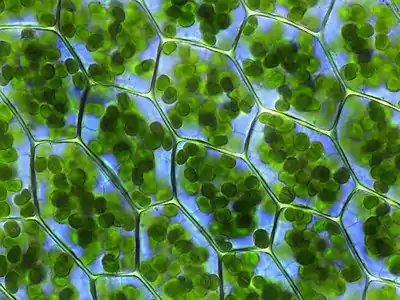Cells

All living things are made of cells. They are the components and building blocks of life.
What is a cell?
A cell is a bag of liquid that holds in the stuff of life.
A cell is the smallest structural and functional unit of a living (things) organism. Cell comes from the Latin word cella which means small room. If you look at living things under a microscope, you will see that they are made of small squares or balls. Robert Hooke, a biologist from England, saw small squares in cork with a microscope. They looked like rooms. He was the first person to observe dead cells
What types of cells are there?
There are two kinds of cells: eukaryotes, which have a large ball in them called a nucleus, and prokaryotes, which do not.
Most prokaryotes are very small. Prokaryotes include just two kingdoms: Bacteria and Archea. All of the rest of the kingdoms are Eukaryotes: Animals , Plants, Fungi, and Protists.
What do cells look like?
Cells are surrounded by a thin oil layer called the cell membrane. It separates the inside of the cell from the outside. Some cells also have a firm box around them called a cell wall that keeps it from breaking. The water that fills a cell is called the cytoplasm. Inside a cell, knowledge is stored in a thing called a chromosome. It tells the cell how to work, like steps in a book.
Eukaryotic cells hold their chromosomes in a structure called a nucleus, which has its own oily membrane around it. Cells also have many other membrane-bound things called organelles, which means "little organs". Some organelles found in eukaryotic cells are called ribosomes, vacuoles, mitochondria, and chloroplasts.

Cells that do different things have different shapes. A plant leaf cell takes light and uses it to make sugar. To do this, it has green organelles called chloroplasts. To get the most light it pushes cytoplasm in circles around a hollow bubble of water in the center of the cell called a vacuole.
A human sperm cell carries its chromosomes, found in the nucleus, to an egg cell in order to make a new baby. It has a large tail called a flagella that helps it to swim. It also has many organelles called mitochondria that give it power like gasoline gives power to a motor.
Words
- nucleus - A ball of membrane in the middle of the cell that holds the chromosomes.
- chromosomes - Things that hold the knowledge of the cell.
- prokaryote - A cell without a nucleus.
- eukaryote - A cell with a nucleus.
- organelles - Little things inside a cell.
- cytoplasm - The gel-like inside of a cell.
- membrane - An oil bag that holds water.
- vacuole - An organelle full of water and waste inside a cell.
- mitochondria - An organelle that makes power in a cell.
- chloroplast - An organelle that makes sugar found in a plant or protist.
- flagella - A tail on a cell that makes it swim.
- golgi body - An organelle which helps in secretion.
- ribosome - An organelle which helps in synthesis of proteins.